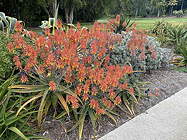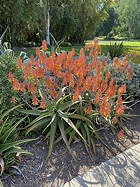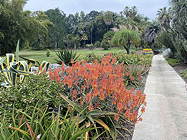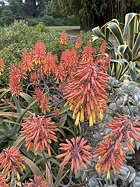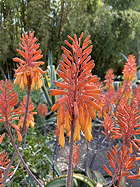In April and May of 1956, aloe authority Gilbert Westacott Reynolds travelled over 3,000 miles through Eritrea and Ethiopia investigating aloes. Ten species encountered were subsequently described as new to science. Samples of four of these were sent back to Johannesburg to flower and be described later. Six, including this one, were published the following year in the South African Journal of Botany (SAJB 23(1): 3 -5, 1957). Like the more familiar A. camperi which is also of Ethiopian origin, the related A. sinana seems to be particularly well suited to cultivation in southern California. It is larger than A. camperi, with longer leaves featuring attractive lenticular spots and reddish, toothy margins. It also bears more slender, taller inflorescences characterized by its flowers spreading horizontally or slightly downwards. These are clavate as in A. camperi. We received two plants from Thomas Cole, November 2, 2016. These were planted in the lower Desert Garden June, 2017. Both flowered in 2021 and the inflorescences were bagged to exclude uncontrolled pollination. The flowers were subsequently hand-pollinated from June to July, 2021. The seed was sown October 15, 2021. These are now large enough for this offering, HBG 145784, from controlled pollination of HBG 127286, T. Cole 13013, from seed collected in Ethiopia; Amhara District; 10 km N of Debre Sina, the place for which the species is named. According to Reynolds, this is in the heart of the dense population and near the type locality which Reynolds designated in his original description as 18 km NE of Debre Sina. $12.

Published in the Cactus and Succulent Journal, Vol. 97 (2), Summer 2025
